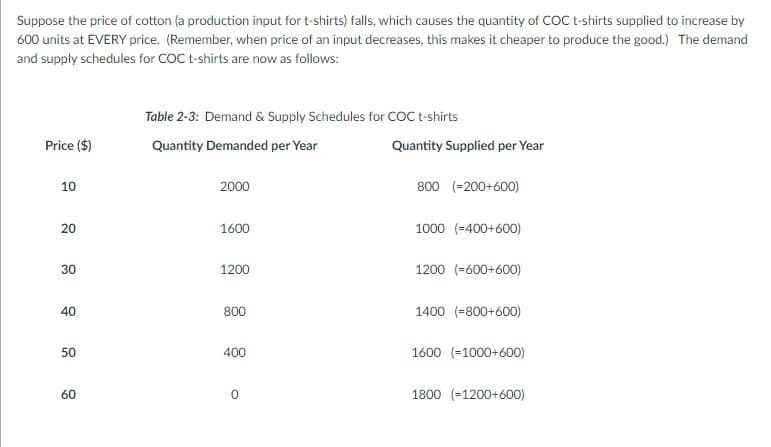Suppose the price of cotton (a production input for t-shirts) falls, which causes the quantity of COC t-shirts supplied to increase by 600 units at EVERY price. (Remember, when price of an input decreases, this makes it cheaper to produce the good.) The demand and supply schedules for COC t-shirts are now as follows: Table 2-3: Demand & Supply Schedules for COC t-shirts Price ($) Quantity Demanded per Year Quantity Supplied per Year 10 2000 800 (-200+600) 20 1600 1000 (-400+600) 30 1200 1200 (-600+600) 40 800 1400 (-800+600) 50 400 1600 (-1000+600) 60 1800 (-1200+600)
Suppose the price of cotton (a production input for t-shirts) falls, which causes the quantity of COC t-shirts supplied to increase by 600 units at EVERY price. (Remember, when price of an input decreases, this makes it cheaper to produce the good.) The demand and supply schedules for COC t-shirts are now as follows: Table 2-3: Demand & Supply Schedules for COC t-shirts Price ($) Quantity Demanded per Year Quantity Supplied per Year 10 2000 800 (-200+600) 20 1600 1000 (-400+600) 30 1200 1200 (-600+600) 40 800 1400 (-800+600) 50 400 1600 (-1000+600) 60 1800 (-1200+600)
Chapter3: Supply And Demand: Theory
Section: Chapter Questions
Problem 1WNG
Related questions
Question
Refer to Table 2-3
What is the new

Transcribed Image Text:Suppose the price of cotton (a production input for t-shirts) falls, which causes the quantity of COC t-shirts supplied to increase by
600 units at EVERY price. (Remember, when price of an input decreases, this makes it cheaper to produce the good.) The demand
and supply schedules for COC t-shirts are now as follows:
Table 2-3: Demand & Supply Schedules for COC t-shirts
Price ($)
Quantity Demanded per Year
Quantity Supplied per Year
10
2000
800 (=200+600)
20
1600
1000 (=400+600)
30
1200
1200 (=600+600)
40
800
1400 (=800+600)
50
400
1600 (=1000+600)
60
1800 (=1200+600)
Expert Solution
This question has been solved!
Explore an expertly crafted, step-by-step solution for a thorough understanding of key concepts.
This is a popular solution!
Trending now
This is a popular solution!
Step by step
Solved in 2 steps

Knowledge Booster
Learn more about
Need a deep-dive on the concept behind this application? Look no further. Learn more about this topic, economics and related others by exploring similar questions and additional content below.Recommended textbooks for you


Economics (MindTap Course List)
Economics
ISBN:
9781337617383
Author:
Roger A. Arnold
Publisher:
Cengage Learning



Economics (MindTap Course List)
Economics
ISBN:
9781337617383
Author:
Roger A. Arnold
Publisher:
Cengage Learning



